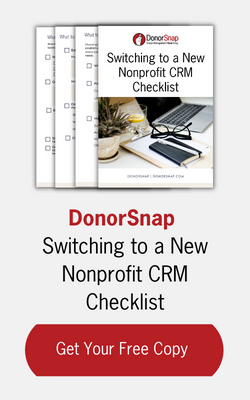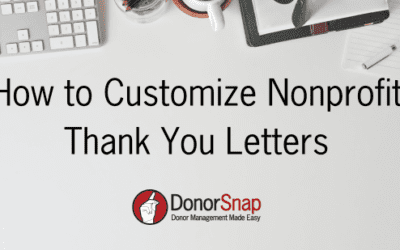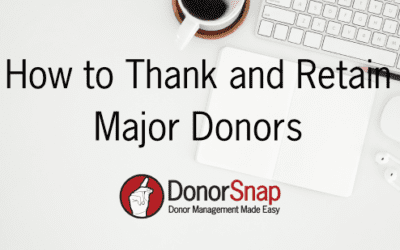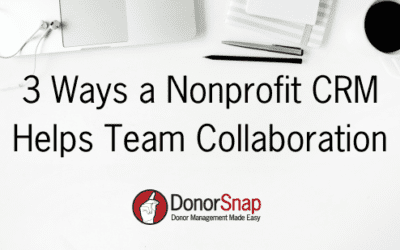Keeping your nonprofit data clean will elevate your fundraising efforts. Clean and organized data will also help you gain the most value from your nonprofit CRM. Messy data can interfere with reporting and communications, and be costly to your organization.
In this article, we will cover everything you need to know about how to clean up your donor data, why good data is important, and how to leverage a donor database to keep it organized.
Below find out why it is important to keep your data clean. From there we will provide the steps you can take to organize it and keep it that way.
Why is it Important to Keep Your Nonprofit Data Clean?
Donor and donation data can provide a wealth of information to your organization. If collected and used properly donor data can help drive better communication and relationship building. However, messy data can cause a number of costly problems in your organization.
Good Data will Help You With Segmentation
Collecting accurate data and keeping it organized will help your nonprofit in a number of ways. Segmentation will help you reach the right people with the right message. When you collect donor data and keep it organized you can easily segment your mailing lists for relevant information. When you are connecting with your donors with the most relevant information to them, you will build trust and lasting relationships.
Good Data Will Provide You with Accurate Reporting
Good data will also provide you with crystal clear reporting and thoughtful insight into your organization. According to a study by Charity Digital, over 82% of nonprofits with a CRM system said it saved them time and increased their income. Using data and reports regularly in your nonprofit will help you make more informed decisions, like which fundraising activities should take priority or which should be cut altogether. In addition, you can be more strategic with your communication and fundraising efforts with good data.
Bad Data Can be Costly to your Organization
Messy data will create a host of problems for your nonprofit organization. When you don’t have accurate donor data, you will be wasting money on mailings going to the wrong place. If you haven’t entered information properly, your lists will not be accurate and you might be reaching the wrong people at the wrong time. Also, if you have inaccurate data, you could be sending your donors mailings with name misspellings or inaccurate information. This in turn will lead to a lack of trust and could result in donor attrition.
Bad Data Will Give you an Inaccurate Look at Your Organization
Just as good data will give you accurate reports, messy data will give you bad reports. If the information you are looking at is inaccurate, this could hurt your organization. For example, say you did a mailing at a certain time of year, and it resulted in many donations. However, someone recording them did not log the proper appeal. You may think that mailing was not a success when it in fact was.
How to Keep Your Donor Data Clean
Now that you understand the importance of good data, let’s take a look at the best ways to keep your donor data clean. Below are steps your nonprofit organization can take to ensure you are keeping accurate records.
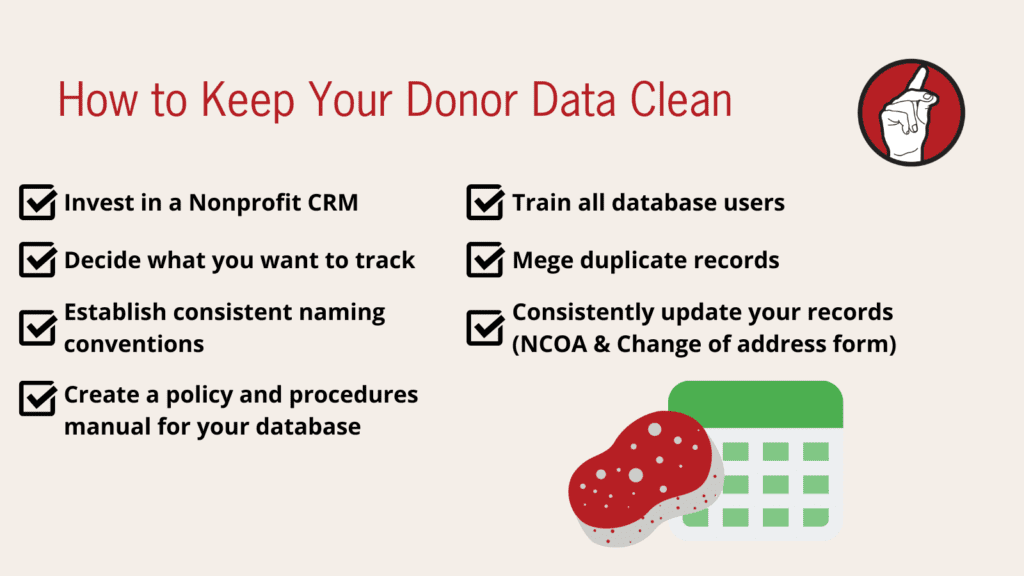
Invest in a Nonprofit CRM
The best way to keep your data clean is to have it all live in a donor database/nonprofit CRM like DonorSnap. If your donor data is living in spreadsheets you are going to have a hard time. There are many reasons a CRM is better than spreadsheets. For one, entering data is simple and efficient in a CRM. Your reporting is also seamless and you don’t have to sift through the spreadsheets to find the specific information that you need. In addition, many CRMs like DonorSnap come equipped with time-saving tools, such as the ability to process acknowledgment letters, collect online donations, or automate important emails.
Decide Goals for Database and What You Want to Track
Once you have gotten your data in a nonprofit CRM, you still need to stay organized to keep your data clean. The first step in maintaining a clean and organized database is to establish goals and what you want to track. Most nonprofits can leverage a CRM to improve communication with donors and build lasting relationships. Every organization is unique, so there are probably specific things you want to track.
Most donor database systems like DonorSnap will come with a standard set of fields. In addition, nonprofits can add their own custom user-defined fields. But these should be properly planned out. Collecting too much unnecessary data can cause problems later on. So make sure you properly plan out your database ahead of time.
One thing to add is that databases are also flexible. Perhaps you start tracking something you later discover is not necessary. You can easily make changes and are not locked into that method of tracking. So although planning out your database is important, don’t stress too much that your plan is permanent.
Establish Consistent Naming Conventions
One reason donor databases can get messy is when different people are entering data in their own way. If you know more than one person will be managing data in the database make sure you are all on the same page for naming conventions. If you run a yearly campaign, ensure that you label them as such. That way reporting will be simple year after year. For example, name your annual campaigns something like “2022 Annual Appeal”. Make sure to include the year and keep it in the same spot so reporting is easy and seamless.
Create a Policy and Procedures Manual for Your Database
People will come and go from your organization but your data will live on. In order to preserve the integrity of your database long-term, it would be helpful to develop a Policy and Procedures manual for using your database. This is where all of your naming conventions can live, as well as detailed explanations for each field in your database. For example, you will want to clearly highlight everything that should be included when entering a donation (date, appeal, campaign, amount, gift type, batch code, etc.) Also, clearly outline what each field means. For example, be clear about the difference between an appeal and a campaign, since this can be a major source of confusion for nonprofits.
Merge Duplicate Records
Duplicate records are another big cause of messy databases. Most nonprofit CRMs like DonorSnap charge based on the number of records in your database. So you want to be sure that you do not have duplicate records floating around your database. Also, if you have duplicate records you will be providing inaccurate information to your donor if their donations are split between the two duplicate records.
For these reasons, you will want to merge duplicate records often. DonorSnap has an easy-to-use tool that will help you merge all your duplicate records. We also have a handy tool that will catch them before you enter them into the database. If you are entering a name into DonorSnap, you will be notified if the same name is already in your database.
Train Anyone Who Will be Using Your Database
One way donor data can get messed up real quickly is if you have someone entering data without the proper training. It is best to only let development professionals enter donation data into your database. If you are using volunteers or other staff members, make sure you provide them with adequate training before doing so. (Expert tip: Set up a Mass Entry batch for volunteers to use to keep them in check.) When you sign on with DonorSnap you are provided with two free, one-on-one training sessions. Make sure you take advantage of the training provided and get anyone who will be entering data onboard. In addition, we provide weekly free webinars that cover best practices for using our CRM.
Run a Yearly NCOA Cleaning
If you run print mail campaigns like most nonprofits, you need to run an NCOA (national change of address) cleaning. Not only is this a requirement, but it will prevent loss in your organization by preventing paying for mail that is delivered to bad addresses. You want to be sure all of the data in your database is the most accurate and up to date. There are many paid services you can use, but DonorSnap provides a free yearly NCOA cleaning to all of our users.
Create a Change of Address Form with Responsive Forms
DonorSnap’s Responsive Forms tool is another feature you can use to keep your records up to date. Simply create a change of address form in DonorSnap, then you can periodically run campaigns to your mailing list asking them to update their information if they have moved. When you import the records into DonorSnap it will auto-link your contacts by email address. From there you can automatically update the contact information in a few clicks. Your change of address forms can be something you include at the bottom of every mailing, with simple text like “Recently Moved – Update Your Contact Information Here” with a link to the form.
Final Thoughts
Taking the time to clean up your donor data will provide a lot of value to your organization. Messy data can hurt your organization in a number of ways. It can provide inaccurate reporting, hurt relationships and cost your organization money. On the other hand, clean data provides many benefits to your organization. Good data offers valuable insights and reporting. It also helps you segment your mailing lists and build more meaningful relationships with your supporters.
There are a number of steps your nonprofit can take to clean up your donor data and keep it organized. These include:
- Investing in a nonprofit CRM
- Decide Goals for Database and What You Want to Track
- Establish Consistent Naming Conventions
- Create a Policy and Procedures Manual for Your Database
- Merge Duplicate Records
- Train Anyone Who Will be Using Your Database
- Run a Yearly NCOA Cleaning
- Create a Change of Address Form with Responsive Forms
Following these steps and creating an overall game plan with your team will ensure that your donor data provides value to your organization for years to come.

